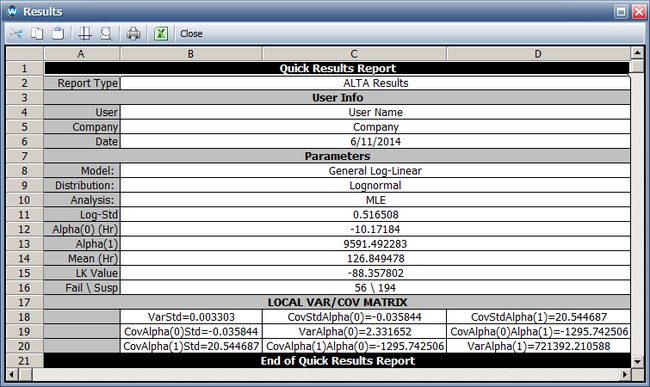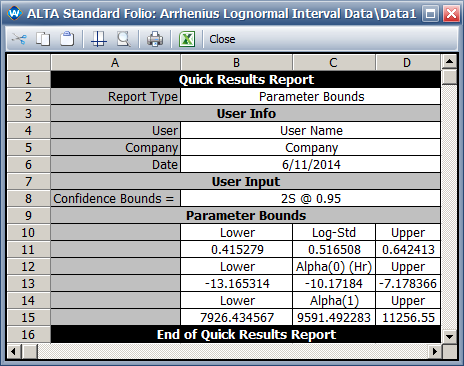Arrhenius-Lognormal Model for Interval Data: Difference between revisions
Jump to navigation
Jump to search
Kate Racaza (talk | contribs) No edit summary |
Kate Racaza (talk | contribs) No edit summary |
||
| Line 48: | Line 48: | ||
where ''T'' is the temperature; <math>\beta_{1}\,\!</math> is the activation energy; 11605 is calculated from the reciprocal of the Boltzmann constant. This function can be written in the following way: | where ''T'' is the temperature; <math>\beta_{1}\,\!</math> is the activation energy; and 11605 is calculated from the reciprocal of the Boltzmann constant. This function can be written in the following way: | ||
::<math>e^{\mu'} = e^{\alpha_{0}+ \frac {\alpha_{1}}{T}}\,\!</math> | ::<math>e^{\mu'} = e^{\alpha_{0}+ \frac {\alpha_{1}}{T}}\,\!</math> | ||
| Line 56: | Line 55: | ||
The above equation is the general log-linear model in ALTA. In ALTA, the coefficients are denoted by <math>\alpha_{i}\,\!</math>. We can see <math>\beta_{0} = \alpha_{0}\,\!</math> and <math>\beta_{1} = \frac{\alpha_{1}}{11605}\,\!</math>. | The above equation is the general log-linear model in ALTA. In ALTA, the coefficients are denoted by <math>\alpha_{i}\,\!</math>. We can see <math>\beta_{0} = \alpha_{0}\,\!</math> and <math>\beta_{1} = \frac{\alpha_{1}}{11605}\,\!</math>. | ||
In fact, the above model also | In fact, the above model can also be expressed using the traditional Arrhenius model: | ||
::<math>e^{\mu'} = e^{\alpha_{0}+ \frac {\alpha_{1}}{T}} = C \times e^{\frac{B}{T}}\,\!</math> | ::<math>e^{\mu'} = e^{\alpha_{0}+ \frac {\alpha_{1}}{T}} = C \times e^{\frac{B}{T}}\,\!</math> | ||
| Line 74: | Line 73: | ||
* The following picture shows the ML estimations for the model parameters in ALTA and the log-likelihood value (LK Value). | * The following picture shows the ML estimations for the model parameters in ALTA and the log-likelihood value (LK Value). | ||
[[Image: Arrhenius Log results.png|center| | [[Image: Arrhenius Log results.png|center|650px]] | ||
The picture above also shows the standard deviations of the parameters. These are: <math>std(\sigma)\,\!</math> = 0.06, <math>std(\beta_{0})\,\!</math> = 1.5, <math>std(\beta_{1})\,\!</math> = 0.07. Therefore, their variances are: <math>Var(\sigma)\,\!</math> = 0.0036, <math>Var(\beta_{0})\,\!</math> = 2.25, <math>Var(\beta_{1})\,\!</math> = 0.0049. In terms of <math>\alpha_{1}\,\!</math> , the variance is <math>Var(\alpha_{1})\,\!</math> = 11605<sup>2</sup> and <math>Var(\beta_{1})\,\!</math> = 659912.5. | The picture above also shows the standard deviations of the parameters. These are: <math>std(\sigma)\,\!</math> = 0.06, <math>std(\beta_{0})\,\!</math> = 1.5, <math>std(\beta_{1})\,\!</math> = 0.07. Therefore, their variances are: <math>Var(\sigma)\,\!</math> = 0.0036, <math>Var(\beta_{0})\,\!</math> = 2.25, <math>Var(\beta_{1})\,\!</math> = 0.0049. In terms of <math>\alpha_{1}\,\!</math> , the variance is <math>Var(\alpha_{1})\,\!</math> = 11605<sup>2</sup> and <math>Var(\beta_{1})\,\!</math> = 659912.5. | ||
The | The differences in the variance in ALTA and the results in the book are caused by the precision in the book since results are provided only up to the 2nd decimal. | ||
* The 95% two-sided confidence bounds on the parameters are shown next: | * The 95% two-sided confidence bounds on the parameters are shown next: | ||
Revision as of 15:25, 12 June 2014
ALTA_Reference_Examples_Banner.png


